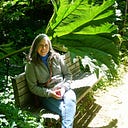Resources for Pollinator Gardens
Planting for pollinators is currently all the rage! And, rightly so, we need our pollinators more than ever even as their populations have declined. The reason for this decline is multi-factorial. Contributing factors are habitat loss, competition of non-native species, pesticide use, climate change, and disease. Stabilization or reversal of pollinator population losses is essential to our very survival as humans. Pollinators, such as bees, butterflies, and even birds, bats, or beetles, make our food grow after pollinating plants. One in every three bites of our food is due to the hard work of pollinators.
Planting a pollinator-friendly garden is easier than ever before with the ease of researching on the internet from your home. The number one rule of thumb I can offer as a former long-time Master Gardener Volunteer and Environmental Educator is to grow plants native to your area of the country. But before you rush out to find those plants, there are a couple of other things you need to consider.
One very important thing to know is your horticultural zone. This is a number designated by the USDA that tells you how much cold a plant can tolerate. The lower the number, the coldest air temperature the plant can tolerate. For example, I live on the Western side of Central Wisconsin. Our zone is 4a. If we go north to our cabin, our zone is 3. If we go east towards Lake Michigan, near Milwaukee the gardeners there enjoy a zone 5. So, even within one state there exists variation in the horticultural zones. Zones are important to know because big box stores and even some nurseries will sell you plants that will not survive if they are grown in the wrong zone.
Plants, especially perennials, are expensive. If you live in zone 5 but put a zone 10 plant, most likely it will not come back the following year. I planted a non-native butterfly bush that was marked for zone 5 and it only survived a few years during which we had mild winters. I won’t plant one again. I learned my lesson.
Another very important thing to consider is your site. How much sun does your garden plot get during the day? Full sun is considered 6–8 hours of sun a day. When picking plants, knowing how much sun your site gets during a day is extremely important. If you live in a drought-prone area, how much water is required for them to grow properly? There are drought-resistant plants such as many of our prairie plants such as echinacea, or coneflowers. You just need to consider the sun on your site.
Perennials are plants that come back every year. They do require some work to divide after 3–5 years for continued healthy growth. Certainly, gardeners are known to share plants (and, knowledge) so don’t worry about getting ride of plants when you have to divide them. So, when looking for pollinator plants, I would select native, perennials first. If yo need more immediate color. Then, fill in with some annuals. Annuals are plants that complete their growing cycle in one season, going from seed to seed. Marigolds, zinnia, and sunflowers are great examples.
I promised some resources at the beginning of this post. As a long-time gardener, I have many suggestions. Luckily, over the past few years organizations that support pollinators have published region-specific guides for planting. These guides make things all the easier for someone who is new to gardening or putting in a new garden bed in a new area of the country.
The Pollinator Partnership offers Ecoregion Guides to help you select the right plants for your area of the country. They are downloadable and free. I would select the guide of the Eastern Broadleaf Continental Forest. Whereas someone on the East Coast might select the Central Appalachian Broadleaf Forest. Within each guide are the scientific and common names of plants, their bloom time and color, as well as a plethora of additional information.
The National Park Service also offers Ecoregion Pollinator Cards for free. Here is the link to the Northeast garden card. There is also this site for northern Virginia on planting natives and suggested plants. Some states have really invested in their quest to have citizens buy and plant natives. For example, here are a set of wonderful guides from the Virginia Native Plant Society. These are separated by region and are offered as free PDF versions for the interested gardener. This website also offers a list of nurseries from which you can obtain native plants.
Gardening is a vast and popular pastime. There is so much to know. But, if one invests in planting natives, your losses will be small and the gains for our pollinators will be great! Pollinators and gardening are two of my favorite topics on which to post! Enjoy!
Today’s post was inspired by a fellow blogger who finds herself in a new state!
Originally published at http://theapplesinmyorchard.com on May 26, 2021.
